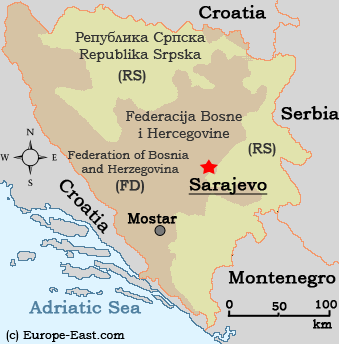Official name
Republika Bosna i Herzegovina (Bosnia and Herzegovina), shortly BiH. The name refers to two historical regions with Herzegovina (also Herzegovina) in the South and Bosnia as the rest of present BiH. The name Herzegovina refers to the German word "Herzog", which means 'duke'. It refers to Duke Stjepan Vukčić, ruler of the South around the 15. century. When talking about Bosnia (from now on used as the short form for Bosnia Herzegovina!), it's necessary to mention two more place names: Federacija Bosne i Hercegovine (abbr.: FD), formerly known as the Muslim Croat Federation (not all Bosniaks are Muslims, hence the change), and the Република Српска (Republika Srpska, abbr. RS), the Serb dominated area. See below for more details.
Area & Population

| ||
| Clickable Map of Bosnia-Herzegovina |
Bosnia covers an area of 51,129 km² (almost twice as big as Massachusetts). 51% of the area belongs to the Federatian (FD), the rest (49%) belongs to the Republika Srpska (RS). Warning: Due to the war, there are minefields left which might cover bigger areas in the countryside and suburbs. If you are not sure, stick to paved areas. Do not ignore mine related warning signs.
The population is almost exactly 4,000,000* (2004); around the same as Alabama.
Around 48% of the population are Bosnians (also called Bosniaks), 37.1% Serbs, 14.3% Croats, 0.6% others (2000) *
Religion
40% Muslems (not all Bosnians are Muslims, hence the gap), 31% Serbian Orthodox, 15% Roman Catholic, 14% others*.
Time zone
As in middle Europe: GMT +01 hr, with daylight-saving time (+1 hour) in summer.
*Source: CIA World Factbook
Serbian. Bosnian. Croatian. The difference between these languages is not very big - as a matter of fact, all of the speakers understand each other well. Serbs and therefore most parts of the Republika Srpska use the Cyrillic alphabet. More about Serbian and the alphabet see →Serbia and Montenegro.
In the Federation, the Roman alphabet is used. Vowels are read as written and follow the Italian/Latin pronunciation system (i = ee as in bee etc). Most consonants are pronounced as in English, but there are some consonants with diacritical marks:
- C (c) is always read as the 'ts' in 'tsar'
- Ć (ć) as 'tch' in 'catch'
- Č (č) slightly weaker as 'ć', as 'ch' in 'chip'
- Đ (đ) soft, close to the 'g' in 'rage'
- H (h) as the 'ch' in the Scottish word 'loch' (phonetical symbol: 'X')
- Š (š) as 'sh' in 'ship'
- Ž (ž) Soft, as the 'g' in 'mirage'
The most remarkable difference between Bosnian and Serbian/Croatian, formerly known as Serbo-Croatian, is the relatively high number of words exported from the →Turkish language, which of course has historical reasons.
For a table with important vocabulary in comparison to other Slavonic languages refer to →Table of Slavic words. In general, getting around with English is not a problem, although a substantial number of Bosniaks rather speak German.
©2024 Europe-East.com

 Albania
Albania Bosnia
Bosnia